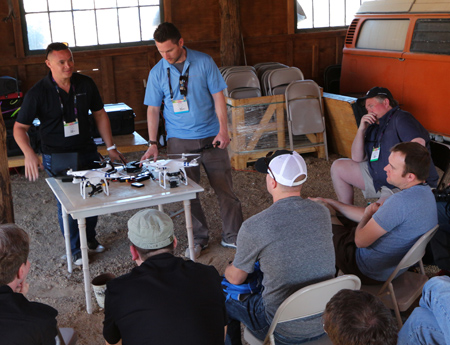FAA OKs Exemptions for TV/Movie Drone Use

The FAA has approved exemptions to drone regulations that will allow TV and movies to use the small, unmanned aircraft to get killer shots without endangering any humans.
“Today’s announcement is a victory for audiences everywhere as it gives filmmakers yet another way to push creative boundaries and create the kinds of scenes and shots we could only imagine just a few years ago," said Motion Picture Association of America chairman and Senator Chris Dodd.
MPAA had lent its support to a request by seven aerial production companies who asked the FAA for an exemption from the Sec. 333 drone restrictions. Six got exemptions, with the FAA saying it was working with the seventh on some issues.
The announcement was made in a conference call with reporters Thursday by Dodd, DOT secretary Anthony Foxx, and FAA administrator Michael Huerta.
Foxx said that the use of drones for production does not pose a hazard to the public, air traffic or national security.
Heuerta said the exemptions were specific to those six production companies, not an entire class of production, but called it "the first step to allowing the film and television industry to use unmanned aircraft systems in our nation's airspace.
It is also a step toward other uses, Foxx said, pointing to some 40 other exemption requests from other industries currently beting vetted.
Broadcasting & Cable Newsletter
The smarter way to stay on top of broadcasting and cable industry. Sign up below
Foxx said that, as of today (Sept. 25), any companies interested in using drones for their businesses "have a model for seeking approval from DOT.
In essence Thursday's announcement was two-fold: Foxx's conclusion that drone use does not pose a hazard to air traffic, and the FAA's exemption framework to insure that is the case.
The drones will not be allowed to fly at night--though DOT said it was willing to revisit that--and will have to operate on closed sets. They can top out at 400 feet, and the TV or movie producer will have to inform FAA when they are going to be used so air traffic can be told.
Huerta said the FAA would be posting on its Web site guidelines for others who wish to seek exemptions, which he welcomed.
"Our industry has a history of successfully using this innovative technology overseas – making movies like Skyfall and Transformers: Age of Extinction, to name a couple – and we are proud to now be on the leading edge of its safe commercial use here at home,” said Dodd. “By creating a climate that further encourages more movie and TV production in the U.S., today’s decision also supports job creation and revenue growth around the country."
Operators of the drones will have to have a private pilot's license and keep the drone in line of sight at all times. The FAA also added a provision that the aircraft will have to be inspected before each flight.
MPAA members have worked with some of the companies on international shoots and it backed providing an exemption to allow for domestic use of unmanned aircraft systems (UAS) for TV and movie production.
MPAA facilitated the request for an exemption from DOT.
Producers joined agriculture firms, as well as power line, pipeline inspection, and oil and gas inspection companies seeking the waiver from regulations on "general flight rules, pilot certificate requirements, manuals, maintenance and equipment mandates and from some airworthiness certification requirements that can be waived in narrowly defined, controlled and low-risk situations."
To receive the exemptions, all the firms must show that their drone operations won't adversely affect safety, and must provide at least the level of safety the rules they are seeking to exempt would mandate. They also have to make a public interest showing.
Currently, waivers are available to public entities like law enforcement, firefighting, border patrol and disaster relief.
The FAA currently allows hobbyists to fly model aircraft up to 400 feet high for non-commercial purposes. It also grants exceptions for law enforcement and other government entities but generally bans commercial applications.
Under the provisions of the FAA Modernization and Reform Act of 2012, Congress mandated that the agency come up with new rules to legalize UAV use by Sept. 30, 2015—George Winslow contributed to this report.
DOT is considering allowing wider commercial application of so-called "small UASs," (unmanned aircraft systems) but says it will first consider the hazards that need to be mitigated.
Contributing editor John Eggerton has been an editor and/or writer on media regulation, legislation and policy for over four decades, including covering the FCC, FTC, Congress, the major media trade associations, and the federal courts. In addition to Multichannel News and Broadcasting + Cable, his work has appeared in Radio World, TV Technology, TV Fax, This Week in Consumer Electronics, Variety and the Encyclopedia Britannica.

